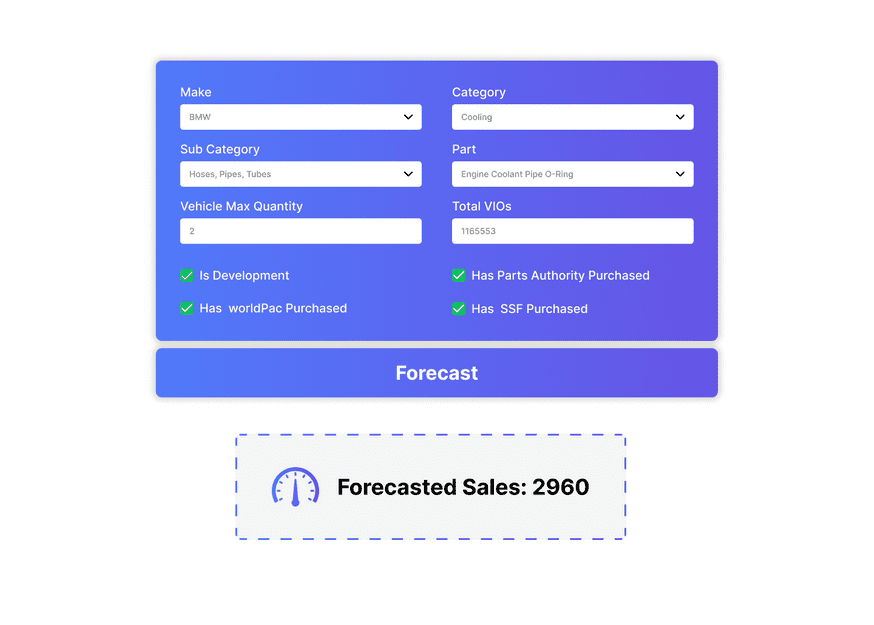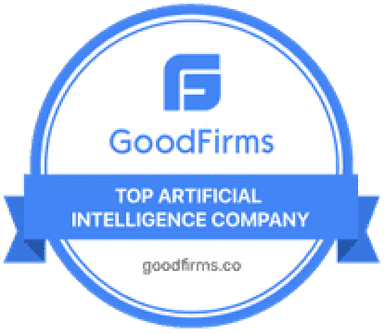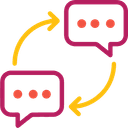Building a Machine Learning Model to Predict the Sales of Auto Parts
Expertise Delivered
Industry
Our client,
Our client, A20 Motors, manufactures more than 10,000 premium-quality spare parts for Asian, American, and European vehicles. They’re one of the largest manufacturers and distributors of aftermarket car and truck parts in Central and South America, North America, Europe, Asia, Australia, and the Caribbean.
Disclaimer - The name A20 Motors is a placeholder as there is an NDA signed between both parties.
Challenge
For the smooth functioning of A20 Motors, correctly stocking up inventory to meet sales and demand of parts is as important as maintaining the highest manufacturing standards for those parts. The team of A20 Motors prepared a mathematical formula to predict the sales cycle of different parts. They used this formula to ensure accurate stocking up of inventory.
As the mathematical formula helped predict the sales cycle, it formed the basis of the most crucial pillars of their business - inventory management, restocking, maintaining the warehouse, and optimizing the shipping process.
Over time, they found that the mathematical formula was not accurately predicting the upcoming demands. It resulted in overstocking & understocking of different parts and, consequently, loss of potential sales and profit.
Solution
A20 Motors wanted to move beyond basic mathematics. They were looking for a more intelligent and advanced solution to accurately forecast the sales of different parts based on historical trends.
More specifically, the client was looking for a statistically derived machine learning model, where they could plug in multiple variables to accurately predict sales of current as well as new parts.
Their VP of Product Development was looking for companies having worked in AI and Machine Learning technologies. After a lot of research, he came across the profile of Maruti Techlabs on Clutch. After a couple of meetings, Maruti Techlabs was chosen as their machine learning solutions partner.
Our client had already spoken with nearly half a dozen companies before stumbling upon Maruti Techlabs. What made Maruti Techlabs stand out?
In their own words-

After finalizing the partnership, we proceeded to conduct a feasibility study on the data provided by the client.
1. Feasibility Study
We started with a feasibility study spanning four weeks, wherein our data engineers determined the correlation between the existing data points and studied the feasibility of the desired solution.
As part of the feasibility study, we refine the available data to make it fit for further processing. It includes data defining, preprocessing, and transformation.
Below are some of the methods used by our data engineers to determine the correlation between different variables in the existing dataset -
- Pearson
- Spearman
- Kendall
We performed other statistical tests like the chi-square test of independence and multicollinearity with VIF (Variable Inflation Factors) to establish levels of independence and correlation between the data points.
2. Model Development
We shortlisted a group of variables as the feature set based on the feasibility analysis. This feature set was then used as input to the machine learning model to predict the desired result (i.e., possible sales for vehicle parts).
The group of variables selected as the feature set was:
- Model / Make
- No. of vehicles in operation
- Part type
- Total units sold per vehicle
Looking at the features set, our data engineers shortlisted three deep-learning algorithms best suiting the feature set-
- Random Forest Regression
- Extreme Gradient Boosting Regression
- Long Short-Term Memory (LSTM)
Various experiments were conducted with these shortlisted algorithms. We finalized the LSTM (Long Short-Term Memory) algorithm and built different models with it to reach maximum accuracy with the existing dataset. The different models we used to conduct more experiments with the dataset were:
- Simple LSTM Model
- LSTM with Z-score > 3 Filtering
- LSTM with Z-score > 5 Filtering
- LSTM with Different Optimizers
- LSTM with Different Loss Functions
- LSTM with Multiple Hidden Layers
- LSTM with Parts Range Predictions
- LSTM with Derived Sale Days
The most stabilized learnings and predictions were seen from LSTM with the Derived Sale Days model. This model now accurately predicted the sales numbers of the vehicle parts.

3. Challenges We Overcame
Predicting sales numbers for newly manufactured parts and parts that were only prototypes was extremely difficult as they had little to no historical data to base our predictions on. To predict sales for new parts/prototypes, we relied on relevant characteristics that the existing parts shared with the prototypes.
The client provided data through their APIs, which resulted in skewed data. It proved to be another significant challenge as it impacted model training greatly. Our team built an API that helped us extract more current data to overcome this. Finally, the model was retrained with the corrected data.
Put your data to work. With intelligent self-learning systems.
Communication & Collaboration
We deployed the following team for the feasibility study as well as the development phase of the project:
- AI Architects to manage the entire project across the business units, DataOps, MLOps, and the extended engineering team.
- ML Engineers build, deploy, and scale the model for production readiness and an ongoing feedback loop.
- Data Scientists & Engineers focus on data integration, modeling, optimization, and quality. They oversee and handpick the suitable datasets and algorithms to build the model with the team of ML Engineers.
- QA Team tests the model and ensures that development standards are maintained, and customer expectations are exceeded.
Our team communicated regularly with the VP of Product Development via weekly sync-up calls on Zoom or Microsoft Teams. For daily updates, we used emails.
Technology Stack
"Maruti Techlabs is attentive to customer service. Their communication is excellent even after the development. They always make sure that we're happy with what we have."
- VP of Product Development, A20 Motors
Our Development Process
We follow Agile, Lean, & DevOps best practices to create a superior prototype that brings your users’ ideas to fruition through collaboration & rapid execution. Our top priority is quick reaction time & accessibility.
We really want to be your extended team, so apart from the regular meetings, you can be sure that each of our team members is one phone call, email, or message away.
Is your business ready for machine learning yet? Let’s find out!
Our machine learning consultants help you identify business challenges to resolve and find functional solutions by following the 7 step approach to implementing machine learning solutions.
AI Readiness Audit
Finding the right AI partner is no easy task.
Building an AI product that delivers on value, is even more challenging.
We help you get started with a slightly different approach. Before we get into the trenches and kickstart development, we take a top-down approach with an AI Readiness Audit.
This involves really validating the idea, through qualitative and quantitative analysis of your datasets, identifying the best fit approach to model development, and putting together an implementation roadmap.
All this before writing a single line of code, and investing heavily into the idea.
Achieve more with less.

































